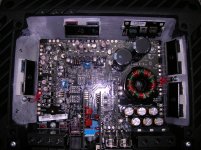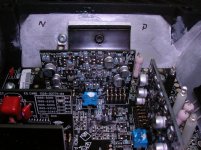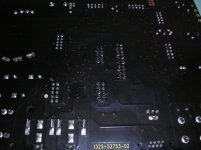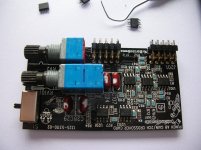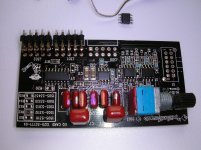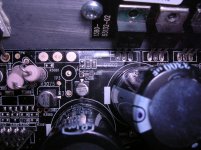Okay, I got this amp , after waiting some time , , ,
Well, nothing else open , I noticed that someone has tried to repair it .... Mosfet output of the left channel , shows that have been removed , (marked on the chassis with permanent marker channel p and n channel ) and then re- install, also cards gain controls and switches have been extracted and then installed again ( you see photo 3)
I've done some measurements , and I have not found , any mosfet short or drivers , look good apparently (rail voltage is present in them, 31.40 volts)
When I logged in , I noticed the following:
Connected to input an audio signal and the output speaker produce a crackling noise and flashing in the left channel, more than the right channel (left channel 0,161 volts and 0,031 volts right channel ) .
The LM337 regulator becomes hot , and after 5 minutes , a blown 15 amp fuse that I had put on B + .
Any idea ?
Well, nothing else open , I noticed that someone has tried to repair it .... Mosfet output of the left channel , shows that have been removed , (marked on the chassis with permanent marker channel p and n channel ) and then re- install, also cards gain controls and switches have been extracted and then installed again ( you see photo 3)
I've done some measurements , and I have not found , any mosfet short or drivers , look good apparently (rail voltage is present in them, 31.40 volts)
When I logged in , I noticed the following:
Connected to input an audio signal and the output speaker produce a crackling noise and flashing in the left channel, more than the right channel (left channel 0,161 volts and 0,031 volts right channel ) .
The LM337 regulator becomes hot , and after 5 minutes , a blown 15 amp fuse that I had put on B + .
Any idea ?
Attachments
Well, I connected the amplifier , this time with a 25 amp fuse , and has not been cast in the whole process of verification.
In a first place, then connected , without the driver board of the channel that was producing more noise .
I connected an extra tester in series with B + to measure consumption.
I connected a speaker to the audio output of the channel that produced less noise (right channel) , consumption remained , more or less stable , 0.65 to 0.66 amps ( this channel voltage is 0,014 volts )
When testing , this did not seem significant , and , secondly, I installed the card driver produced more noise ( left channel) .
I connected again, a speaker at this last channel , and consumption has started to increase gradually from 1.20 to 2.10 amps. (the voltage at the terminals of this channel is 0.160 volts)
When I connected the speaker in bridge mode between the two channels , consumption has risen to 3.20 amps.
Elapsed time, in all this has been about ten to fifteen minutes.
I have also implemented an audio signal at the input, without noticing any sound in the speaker , even with the maximum gain level .
All this is not very significant , right Perry?
In a first place, then connected , without the driver board of the channel that was producing more noise .
I connected an extra tester in series with B + to measure consumption.
I connected a speaker to the audio output of the channel that produced less noise (right channel) , consumption remained , more or less stable , 0.65 to 0.66 amps ( this channel voltage is 0,014 volts )
When testing , this did not seem significant , and , secondly, I installed the card driver produced more noise ( left channel) .
I connected again, a speaker at this last channel , and consumption has started to increase gradually from 1.20 to 2.10 amps. (the voltage at the terminals of this channel is 0.160 volts)
When I connected the speaker in bridge mode between the two channels , consumption has risen to 3.20 amps.
Elapsed time, in all this has been about ten to fifteen minutes.
I have also implemented an audio signal at the input, without noticing any sound in the speaker , even with the maximum gain level .
All this is not very significant , right Perry?
I have continued doing tests and have concluded that the failure could be on the cards: AB gain/2ch card crossover, and EQ card.
Therefore, I have extracted both from the motherboard, and I proceeded to the check of all its components.
Resistors and capacitors, look good, but U201, AB card, I have extracted, and compare your measurements with a new one, has given me high in some of its pins with respect to new, so I have proceeded to replace, U201, and U203, to suspect them ....
I have also seen on the card, EQ card, which seemed to have been tampered with before ... for example: pin 5 of U7, seems to have a bridge between him and a track circuit,,,
Is this correct, Perry? Do you have another card like this, to know if it's that made?
Therefore, I have extracted both from the motherboard, and I proceeded to the check of all its components.
Resistors and capacitors, look good, but U201, AB card, I have extracted, and compare your measurements with a new one, has given me high in some of its pins with respect to new, so I have proceeded to replace, U201, and U203, to suspect them ....
I have also seen on the card, EQ card, which seemed to have been tampered with before ... for example: pin 5 of U7, seems to have a bridge between him and a track circuit,,,
Is this correct, Perry? Do you have another card like this, to know if it's that made?
Attachments
A few days ago , I came back to start this fix, I had forgotten ..
And amazingly , and without any cause , ( this is the weirdest thing that has ever happened to me with an amplifier ... ) when I connected with the audio signal input , it has started to work! but , as I had taken by surprise, I had not set the output fets the sink, and have burned a channel ...
I've extracted , ( already have new orders ) and have retested the amplifier with audio signal at the input, the only channel that works, and these are " strange results "
When connected , everything seems fine , but only for five minutes , after which , the speaker sound begins to cut , and sound increasingly lower, until only a sparkling noises are heard , (similar to pink noise, but ups and downs ..)
If I disconnect and reconnect , follow these noises , when connected 24 hours elapsed , works well for five minutes and then the same thing happens again ...
So testing it took three days ...
What say ? Can be any electrolytic capacitor ?
Because a transistor or an IC not think it , do you , yes ?
And amazingly , and without any cause , ( this is the weirdest thing that has ever happened to me with an amplifier ... ) when I connected with the audio signal input , it has started to work! but , as I had taken by surprise, I had not set the output fets the sink, and have burned a channel ...
I've extracted , ( already have new orders ) and have retested the amplifier with audio signal at the input, the only channel that works, and these are " strange results "
When connected , everything seems fine , but only for five minutes , after which , the speaker sound begins to cut , and sound increasingly lower, until only a sparkling noises are heard , (similar to pink noise, but ups and downs ..)
If I disconnect and reconnect , follow these noises , when connected 24 hours elapsed , works well for five minutes and then the same thing happens again ...
So testing it took three days ...
What say ? Can be any electrolytic capacitor ?
Because a transistor or an IC not think it , do you , yes ?
Few years ago found very similar issue. In a 400.4 .u7
On x over card I think.
Sent from my GT-I9300 using Tapatalk
On x over card I think.
Sent from my GT-I9300 using Tapatalk
Yes, i checked all the components except...., some tantalum capacitors,...
I'll have to do...
Thanks for your suggestions, Tiomilo.
I'll have to do...
Thanks for your suggestions, Tiomilo.
Well, today, I'm happier ....🙂
I followed all parts checking the last few days, until today, I found R1015 (originally marked 49R9) that had a small black dot in the "R", and has made me suspicious .... as soon as I measured, I was, 0,985 K, when it should be 50 ohms!
I've substituted the nearest value that I had in my closet, (60 ohms, see photo)
The amp seems to work perfectly for some time.
My question is: do you think I can leave this resistor installed, or, should I install the original value?
I followed all parts checking the last few days, until today, I found R1015 (originally marked 49R9) that had a small black dot in the "R", and has made me suspicious .... as soon as I measured, I was, 0,985 K, when it should be 50 ohms!
I've substituted the nearest value that I had in my closet, (60 ohms, see photo)
The amp seems to work perfectly for some time.
My question is: do you think I can leave this resistor installed, or, should I install the original value?
Attachments
The higher value resistor may decrease the supply voltage for the preamp ICs (op-amps) and may cause the resistor to operate at a slightly higher temperature.
If this is your amp, you can leave it as is. If it's for a paying customer or you intend to sell it, I'd recommend using the correct value.
If this is your amp, you can leave it as is. If it's for a paying customer or you intend to sell it, I'd recommend using the correct value.
Ok, Perry, I'll do so, look for the resistor to the original value, and I will set it up.
Yes, I have intention of selling.
Thank you very much for everything, everyone, and especially to Perry, is a genius, and never tire of commend.
Greetings from Spain.
Yes, I have intention of selling.
Thank you very much for everything, everyone, and especially to Perry, is a genius, and never tire of commend.
Greetings from Spain.
- Status
- Not open for further replies.
- Home
- General Interest
- Car Audio
- Rockford Fosgate Punch P400-2
